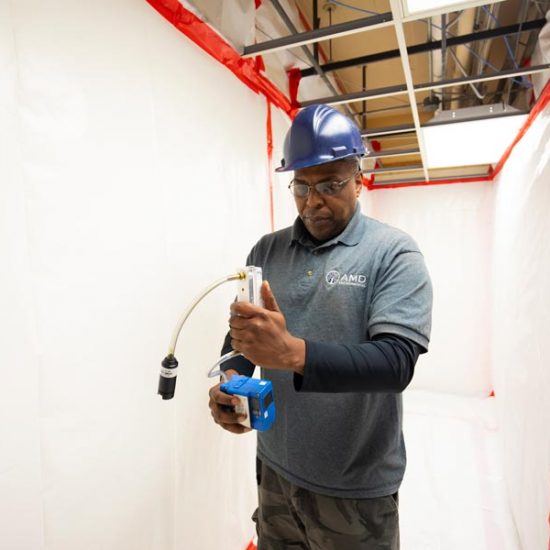Your Guide to Effective Asbestos Examining Treatments
Asbestos screening procedures are a crucial component of making certain the security of indoor settings, particularly in older buildings where this hazardous product may exist. The possible health and wellness risks related to asbestos exposure make it vital to approach screening with accuracy and thoroughness. From understanding the residential properties of asbestos to efficiently interpreting examination outcomes, an extensive overview can outfit people with the understanding and tools required to navigate this intricate process. Stay tuned to reveal the necessary steps and considerations that can help you guard against the dangers presented by asbestos.
Comprehending Asbestos and Its Dangers
Asbestos, a naturally taking place mineral known for its heat resistance and resilience, postures severe wellness risks when its fibers are inhaled or ingested. asbestos survey near me. Exposure to asbestos can result in severe wellness conditions such as lung mesothelioma cancer, asbestosis, and cancer. Despite its valuable buildings, asbestos has been commonly outlawed in several countries due to the tested web link in between asbestos direct exposure and these life-threatening diseases
The danger lies in the microscopic fibers that can quickly end up being air-borne when asbestos-containing materials are disturbed or harmed. As soon as breathed in, these fibers can end up being lodged in the lungs, causing swelling and scarring gradually. The latency period between direct exposure to asbestos and the advancement of related diseases can extend a number of decades, making very early detection and prevention essential.
Asbestos was frequently used in construction products, insulation, and vehicle parts prior to its health and wellness dangers were fully understood. Today, correct screening and removal of asbestos-containing products are necessary to shield individuals from the dangers connected with asbestos exposure.
Identifying Possible Asbestos Materials
The recognition of possible asbestos materials is an essential step in making sure the safety of individuals subjected to hazardous compounds in numerous settings. Asbestos can be found in a large array of building materials, including yet not limited to insulation, ceiling ceramic tiles, flooring ceramic tiles, concrete sheets, and roofing roof shingles - Asbestos Air Sampling. Determining these materials precisely is vital to efficiently handling the threats connected with asbestos direct exposure

In instances where aesthetic assessment is inconclusive, examples of presumed materials can be collected and sent out to recognized labs for testing. These laboratories use specialized methods such as polarized light microscopy or transmission electron microscopy to accurately establish the existence of asbestos fibers in the samples. By following strenuous identification treatments, individuals can effectively alleviate the threats related to asbestos exposure.
Selecting the Right Screening Method
Identification of prospective asbestos products plays a critical duty in establishing the proper testing approach for precise asbestos fiber detection. There are 2 main methods for asbestos screening: polarized light microscopy (PLM) and transmission electron microscopy (TEM) It is vital to consult with accredited asbestos screening experts to determine the most ideal technique for your specific screening needs.
Performing Sample Collection Securely
When gathering examples for asbestos testing, focusing on precaution is vital to reduce possible exposure dangers. Asbestos fibers are hazardous when interrupted, making it essential to adhere to appropriate safety and security protocols throughout sample collection - asbestos testing cost. Prior to starting the sampling procedure, make sure that you are More Info equipped with individual protective equipment (PPE) such as non reusable coveralls, masks, handwear covers, and safety glasses to avoid inhalation or call with asbestos fibers
It is vital to damp the sampling area using a mild mist of water to stop the fibers from becoming airborne during collection. When collecting samples and prevent aggressive scuffing or piercing go to this website that might launch asbestos fibers right into the air, Usage care. Rather, meticulously reduced a small piece of the material using suitable tools and put it into a sealed container for analysis by a qualified research laboratory.
Furthermore, labeling each sample with detailed information concerning the sampling enthusiast, day, and place's name is necessary for exact record-keeping and analysis. By complying with these safety guidelines, you can conduct example collection for asbestos screening successfully while lessening the danger of exposure.
Interpreting Test Outcomes and Following Steps

Conclusion
Finally, reliable asbestos testing treatments are important in recognizing and managing possible health dangers related to asbestos exposure. By recognizing the dangers of asbestos, determining potential materials, picking the right screening approach, carrying out example collection safely, and analyzing test results precisely, people and my blog organizations can take the necessary steps to shield themselves and others from the unsafe effects of asbestos. It is vital to focus on security and correct testing methods to guarantee a healthy and balanced environment for all.

Identification of potential asbestos products plays a crucial duty in establishing the ideal screening method for accurate asbestos fiber discovery. The test results will certainly suggest the presence or lack of asbestos, the kind of asbestos fibers present, and the focus levels.In conclusion, reliable asbestos testing procedures are crucial in recognizing and handling potential wellness risks linked with asbestos direct exposure. By comprehending the threats of asbestos, determining potential products, choosing the appropriate screening method, performing sample collection securely, and translating examination results precisely, organizations and people can take the required actions to secure themselves and others from the hazardous results of asbestos.